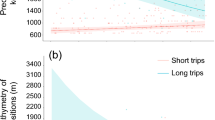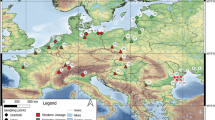Abstract
The importance of genetic variation in evolution is well established. Yet, the mechanisms by which genetic variation—particularly variation in traits under selection—is maintained in natural populations has long been an evolutionary puzzle. Understanding individual variables driving selection and their functional mechanisms is increasingly important in the context of global change and its potential consequences for biodiversity. Here we examined intra-population performance among allelic variants of a pleiotropic locus in response to thermal stress in the variable platyfish, Xiphophorus variatus. The wild-type tailspot allele exhibited significantly lower heat tolerance than all three pattern alleles found in the population, conforming to predictions based on previously observed correlations between temperature and pattern frequencies in the wild. Furthermore, differences between tailspot pattern frequencies in adults and juveniles were broadly consistent with this trend. Thus, it appears that physiological stress and reduced performance of the wild-type allele at higher relative temperatures is a mechanism balancing its frequency in natural populations. Temperature variation and not dissolved oxygen alone, as previously reported, is likely a important abiotic variable contributing to the maintenance of adaptive polymorphism. Furthermore, our findings underscore the potential implications of rising temperatures and physiological stress for levels of genetic variation in natural populations.


Similar content being viewed by others
References
APHA (1992) Standard methods for the examination of water and wastewater, 18th edn. American Public Health Association, Washington, DC
Barrett RDH, Rogers SM, Schluter D (2009) Environment-specific pleiotropy facilitates divergence at the ectodyplasin locus in threespine stickleback. Evolution 63:2831–2867
Belk MC, Smith MH (1996) Pelage coloration in oldfield mice (Peromyscus polionotus): antipredator adaptation? J. Mamm. 77:882–890
Bisazza A, Marin G (1995) Sexual selection and sexual size dimorphism in the eastern mosquitofish Gambusia holbrooki (Pisces: Poeciliidae). Ethol Ecol Evol 7:169–183
Bockelmann AC, Reusch TBH, Bijlsma R, Bakker JP (2003) Habitat differentiation vs. isolation-by-distance: the genetic population structure of Elymus athericus in European salt marshes. Mol Ecol 12:505–515
Borowsky R, Kallman KD (1976) Patterns of mating in natural populations of Xiphophorus (Pisces: Poeciliidae). I: X. maculatus from Belize and Mexico. Evolution 30:693–706
Borowsky R, Kallman K (1993) Genetic variation of fat and glycogen storage in Xiphophorus variatus (Pisces, Poeciliidae). Comp Biochem Phys A 105:579–586
Borowsky R, Khouri J (1976) Patterns of mating in natural populations of Xiphophorus II. X. variatus from Tamaulipas, Mexico. Copeia 1976:727–734
Borowsky R, Khouri J (1978) The tailspot polymorphism of Xiphophorus (Pisces: Poeciliidae). Evolution 32:886–893
Borowsky R, Khouri J (1984) The evolutionary genetics of Xiphophorus. In: Turner BJ (ed) Evolutionary genetics of fishes. Plenum Publishing Corp, New York, pp 235–310
Borowsky R, Khouri J (1990) Habitat choice by allelic variants in Xiphophorus variatus (Pisces, Poeciliidae) and implications for maintenance of genetic-polymorphism. Evolution 44:1338–1345
Cook LM (2003) The rise and fall of the carbonaria form of the peppered moth. Q Rev Biol 78:399–417
Culumber ZW, Shepard DB, Coleman SW, Rosenthal GG, Tobler M (2012) Physiological adaptation along environmental gradients and replicated hybrid zone structure in swordtails (Teleostei: Xiphophorus). J Evol Biol 25:1800–1814
Endler JA (1978) Natural and sexual selection on color patterns in poeciliid fishes. Environ Biol Fishes 9(173):190
Endler JA (1980) Natural selection on color patterns in Poecilia reticulata. Evolution 34:76–91
Endler JA (1995) Multiple-trait coevolution and environmental gradients in guppies. Trends Ecol Evol 10:22–29
Felsenstein J (1976) Theoretical population genetics of variable selection and migration. Ann Rev Genet 10:253–280
Fernandez AA, Bowser PR (2010) Selection for a dominant oncogene and large male size as a risk factor for melanoma in the Xiphophorus animal model. Mol Ecol 19:3114–3123
Frankham R (2005) Genetics and extinction. Biol Conserv 126:131–140
Hedrick PW (2006) Genetic polymorphism in heterogeneous environments: the age of genomics. Ann Rev Ecol Evol Syst 37:67–93
Hedrick PW, Ginevan ME, Ewing EP (1976) Genetic polymorphism in heterogeneous environments. Ann Rev Ecol Evol Syst 7:1–32
Helmuth B, Harley CDG, Halpin PM, O’Donnell M, Hofmann GE, Blanchette CA (2002) Climate change and latitudinal patterns of intertidal thermal stress. Science 298:1015–1017
Hoekstra HE, Drumm KE, Nachman MW (2004) Ecological genetics of adaptive color polymorphism in pocket mice: geographic variation in selected and neutral genes. Evolution 58:1329–1341
Hoffman AA, Harshman LG (1999) Desiccation and starvation resistance in Drosophila: patterns of variation at the species, population and intrapopulation levels. Heredity 83:637–643
Huestis DL, Oppert B, Marshall JL (2009) Geographic distributions of Idh-1 alleles in a cricket are linked to differential enzyme kinetic performance across thermal environments. BMC Evol Biol 9:113
Hughes KA, Du L, Rodd FH, Reznick DN (1999) Familiarity leads to female mate preference for novel males in the guppy. Poecilia reticulata. Anim Behav 58:907–916
Kingston J, Rosenthal GG, Ryan MJ (2003) The role of sexual selection in maintaining a colour polymorphism in the pygmy swordtail Xiphophorus pygmaeus. Anim Behav 65:735–743
Kover PX, Rowntree JK, Scarcelli N, Savriama Y, Eldridge T, Schaal BA (2009) Pleiotropic effects of environmental-specific adaptation in Arabidopsis thaliana. New Phytol 183:816–825
Kramer DL, Mehegan JP (1981) Aquatic surface respiration, an adaptive response to hypoxia in the guppy, Poecilia reticulata (Pisces, Poeciliidae). Environ Biol Fishes 6:299–313
Kramer DL, McClure M (1982a) Aquatic surface respiration, a widespread adaptation to hypoxia in tropical freshwater fishes. Environ Biol Fishes 7:47–55
Kramer DL, McClure M (1982b) Aquatic surface respiration, a widespread adaptation to hypoxia in tropical freshwater fishes. Environ Biol Fishes 7:47–55
Lukens LN, Doebley J (1999) Epistatic and environmental interactions for quantitative trait loci involved in maize evolution. Genet Res 74:291–302
MacColl ADC (2011) The ecological causes of evolution. Trends Ecol Evol 26:514–522
Magurran AE, Seghers BH (1990) Risk sensitive courtship in the guppy (Poecilia reticulata). Behaviour 112:194–201
Manel S (2012) Adaptive genetic variation on the landscape: methods and cases. Ann Rev Ecol Evol Syst 43:23–43
Marcogliese DJ (2008) The impact of climate change on the parasites and infectious diseases of aquatic animals. Rev Sci Tech 27:467–484
Mensch J, Lavagnino N, Carreira VP, Massaldi A, Hasson E, Fanara JJ (2008) Identifying candidate genes affecting developmental time in Drosophila melanogaster: pervasive pleiotropy and gene-by-environment interaction. BMC Dev Biol 8:78–90
Mitchell-Olds T, Willis JH, Goldstein DB (2007) Which evolutionary processes influence natural genetic variation for phenotypic traits? Nat Rev Genet 8:845–856
Morris MR, Nicoletto PF, Hesselman E (2003) A polymorphism in female preference for a polymorphic male trait in the swordtail fish Xiphophorus cortezi. Anim Behav 65:45–52
Nachman MW, Hoekstra HE, D’Agostino SL (2003) The genetic basis of adaptive melanism in pocket mice. Proc Natl Acad Sci 100:5268–5273
Neff BD, Cargnelli LM (2004) Relationship between condition factors, parasite load and paternity in bluegill sunfish, Lepomis macrochirus. Environ Biol Fish 71:297–304
Pankhurst NW, Munday PL (2011) Effects of climate change on fish reproduction and early life history stages. Mar Freshw Res 62:1015–1026
Parmesan C (2006) Ecological and evolutionary responses to recent climate change. Ann Rev Ecol Evol Syst 37:637–669
Piertney SB, Oliver MK (2006) The evolutionary ecology of the major histocompatibility complex. Heredity 96:7–21
Plath M, Makowicz AM, Schlupp I, Tobler M (2007) Sexual harassment in live- bearing fishes (Poeciliidae): comparing courting and noncourting species. Behav Ecol 18:680–688
Pörtner HO (2001) Climate change and temperature-dependent biogeography: oxygen limitation of thermal tolerance in animals. Naturwissenschaften 88:137–146
Pörtner HO, Mark FC, Bock C (2004) Oxygen limited thermal tolerance in fish? Answers obtained by nuclear magnetic resonance techniques. Respir Physiol Neurobiol 141:243–260
Reed DH, Frankham R (2003) Correlation between fitness and genetic diversity. Conserv Biol 17:230–237
Reznick DN, Braun B (1987) Fat cycling in the mosquitofish (Gambusia affinis): fat storage as a reproductive adaptation. Oecologia 73:401–413
Rosenthal GG, García de León FJ (2011) Speciation and hybridization. In: Schlupp I, Pilastro A, Evans J (eds) Ecology and evolution of Poeciliid Fishes. University of Chicago Press, Chicago, pp 109–119
Rutledge CJ, Beitinger TL (1989) The effects of dissolved oxygen and aquatic surface respiration on the critical thermal maxima of three intermittent-stream fishes. Environ Biol Fishes 24:137–143
Scarcelli N, Cheverud JM, Schaal BA, Kover PX (2007) Antagonistic pleiotropic effects reduce the potential adaptive value of the FRIGIDA locus. Proc Natl Acad Sci 104:16986–16991
Schmidt PS, Conde DR (2006) Environmental heterogeneity and the maintenance of genetic variation for reproductive diapause in Drosophila melanogaster. Evolution 60:1602–1611
Schmidt PS, Rand DM (2001) Adaptive maintenance of genetic polymorphism in an intertidal barnacle: habitat- and life-stage-specific survivorship of Mpi genotypes. Evolution 55:1336–1344
Spielman D, Brook BW, Briscoe DA, Frankham R (2004) Does inbreeding and loss of genetic diversity decrease disease resistance? Conserv Genet 5:439–448
Yeaman S, Chen Y, Whitlock MC (2010) No effect of environmental heterogeneity on the maintenance of genetic variation in wing shape in Drosophila melanogaster. Evolution 64:3398–3408
Acknowledgments
We would like to thank the Mexican Government for collecting permits. We thank Gil Rosenthal (Texas A&M University, College Station, TX) who allowed us to use the facilities at the CICHAZ field station (http://www.cichaz.org/). This work was supported by a Consejo Nacional de Ciencia y Tecnología (CONACyT) Grant in basic science (Clave 0127310) to SM which supported ZWC as a postdoctoral researcher. CEBH was supported by a CONACyT scholarship (Clave 254023).
Author information
Authors and Affiliations
Corresponding author
Rights and permissions
About this article
Cite this article
Culumber, Z.W., Bautista-Hernández, C.E. & Monks, S. Physiological stress and the maintenance of adaptive genetic variation in a livebearing fish. Evol Ecol 28, 117–129 (2014). https://doi.org/10.1007/s10682-013-9663-x
Received:
Accepted:
Published:
Issue Date:
DOI: https://doi.org/10.1007/s10682-013-9663-x




